
MARK PERAKH
257
KGB did its utmost to suppress the
Chronicle of Current Events,
but in
vain. Despite countless persecutions and arrests of all eged editors of
this magazine, it continued
to
appear, apparently changing editorial
boards, while imprisoned contributors of the
Chronicle
were immedi–
ately replaced by several others . Recently (September 1976), Issue no. 40
of the
Chronicle
was reported to have appeared. Several other under–
ground papers continue
to
appear to this day, circulating throughout
the country and demonstrating the complete alienation of the authori–
ties from the people.
Once again, it shou ld be stressed that all these underground
journals, well-known in the West, represent only a drop in the bucket.
In addition
to
these publications, many others remain relatively
unknown. At the end of the sixties in Krassnoyarsk, a large industrial
town in Eastern Siberia, an extremely anti-Soviet group consisting of
students and young workers was established that attempted not only to
spread antigovernment views, but also to provoke armed struggle
against the authorities. The KGB discovered the group and managed to
conceal its existence from the public. But some information did seep
through the KGB screen . The name of one of the group's main activists
is known - Valery Petraskho, an eighteen-year-old worker. Another
example: in 1969 an underground organization emerged among the
sailors and officers of the Balticum avy, call ed "Union for the
Struggle for Political Rights." Specific details on this group are locked
in the files of the KGB, but all the participants were court-marshall ed
and cruell y punished.
At the end of the sixties and early in the seventies, nationalistic
strivings in many parts of the Soviet empire intensified.
The most significant national movement is in the Ukraine. The
Ukraine is a large region exceeding, for example, the area of France,
with a population of about fifty million and vast natural resources.
Despite hundreds of years of Russian rule, the Ukrainians have
preserved their language and original cu lture. The authorities of
Czarist Russia carried out a forcible russification, and the Soviet rulers
stubbornly con tinue these efforts, implemented
to
a large extent by
Ukrainians themselves. , russified representatives of the indigenous
population who occupy the majority position in the local Party
hierarchy. Hence there is a deep division in the Ukraine between the
russified elite serving the Moscow bosses and the nationally oriented
groups, where a hatred of the Moscow rul ers (and sometimes even of
the Russian people in general) reigns.
In 1969 a Kiev historian, Ivan Dziuba, at the request of Party
officials did research concerning russification in the Ukraine. The


